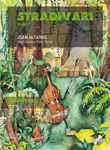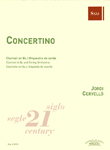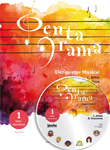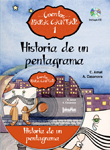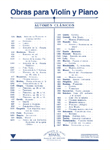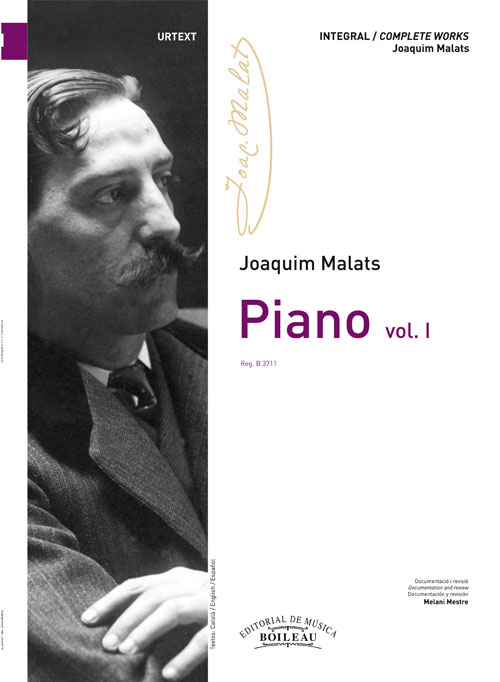Piano, Vol. 1
Piano
MALATS, JoaquimReg.: B.3711
17,60 €
P.V.P. (VAT included 4%)
Add to cart
- Review: MESTRE, Melani
- Ensemble: Solo.
- Genres: Classical / contemporary: Solos.
- Product format: Partitura
- Difficulty level: Intermediate-advanced
- Period: 1st half S. XX
- Publishing house: Editorial Boileau
- Collection: Joaquim Malats
- No. of pages: 56
- Measure: 31,00 x 23,00 cm
- ISMN: 979-0-3503-1037-9
- Available in digital: No
- Available for rent: No
The catalogue of Malats’ compositions cannot be judged on the basis of the number of works included in it. In fact, the list of his works is actually quite small. However, they are not less interesting that those of his contemporaries Albéniz and Granados. Malats’ piano works are the most representative of his compositions for the obvious reason that the piano was his instrument. As an interpreter educated in the most complete Romantic tradition, Malats represented the archetypical complete musician of the 19th Century: pianist, composer, interpreter of his own works, and teacher.
For this reason most of his works are written for the piano, both those works which survive today as well as those which, although known, have been lost or not yet recovered.
La morena cubana (The Dark-Haired Cuban Girl) (Source: it is found in the Biblioteca Nacional de Catalunya) was certainly one of the first works that Malats composed at the beginning of 1890. Occasionally described as an “impresión criolla” (Creole Impression), this piece was written in the form of an habanera. It was published several times by Casa Dotesio, Barcelona. The fourth of these editions, published in 1911, is the basis for the present edition.
One of the most important musical magazines of the time in Barcelona, La Ilustración Musical Hispano-Americana (Hispanic-American Musical Illustration), in the edition of October 15, 1896, published a Barcarola (Barcarolle) (Source: it is found in the Biblioteca Nacional de Catalunya) by Malats that accompanied an article which commented on the great success of the composer as a pianist, as well as the stylistic preferences and musical tastes which defined his artistic personality. On September 21 of that same year another barcarolle, Napoli (Source: it is found in the Biblioteca Nacional de Catalunya), was premiered at the Ateneo in Madrid. This piece was probably written at the beginning of 1890 in Paris while Malats was studying with the celebrated composer Benjamin Godard. It was dedicated to his close friend, the great Catalan pianist Carles G. Vidiella.
While he was studying in Paris, from 1891 to 1895, Malats composed the Deuxième Mazurka (Second Mazurka) (Source: it is found in the Biblioteca Nacional de Catalunya), (Second Mazurka), dedicated to Doña Raymundo Julián Degollada. It was formally premiered on March 11, 1898 at the Ateneo in Madrid. The designation of this mazurka as the second, would seem to indicate the existence of a first mazurka, however no first mazurka has been found.
There is a clear French influence in the works that Malats composed in Paris during those years which is reflected in the titles themselves of some of these pieces. An example of this is Babillage, Caprice pour piano (Source: it is found in the Biblioteca Nacional de Catalunya), dedicated to Mario Calado, one of the most brilliant and respected students of Juan Bautista Pujol. Calado, like Malats, was awarded the First Prize at the Paris Conservatory in 1881 and he became the model for future generations of Catalan pianists in Paris: Granados, Malats, Vinyes, etc. The Sindicato Musical Barcelonés Dotesio published this work 1911, while Malats was still living.
At that time is was common for musicians to dedicate their works to colleagues and friends, a gesture which was frequently reciprocated. One example was Malats’ dedication of Valse-Caprice (Source: it is found in the Biblioteca de l’Orfeó Català Palau de la Música Catalana and in the Biblioteca del Conservatori Municipal de Música de Barcelona) to his respected friend, Isaac Albéniz. This work is virtuostic and composed in the French style of Godard, but with the highly personal melodies and harmonic structures that came to mark the succeeding piano works written by Malats. It is rather curious that this is the only work which has an opus number, Op. 16, however, this opus number does not indicate any chronological order of composition.Valse-Caprice was premiered by the composer in Valencia in April, 1901.
During the preparation of this edition we have utilized current musicological and technical criteria in order to make the scores as clear as possible. In addition, we have corrected a considerable number of errors found in the first editions as well as in the original manuscripts, when available.
Barcarola
Napoli (Barcarola)
Deuxième Mazurca
Babillage (Caprice)
Vals - Caprice

